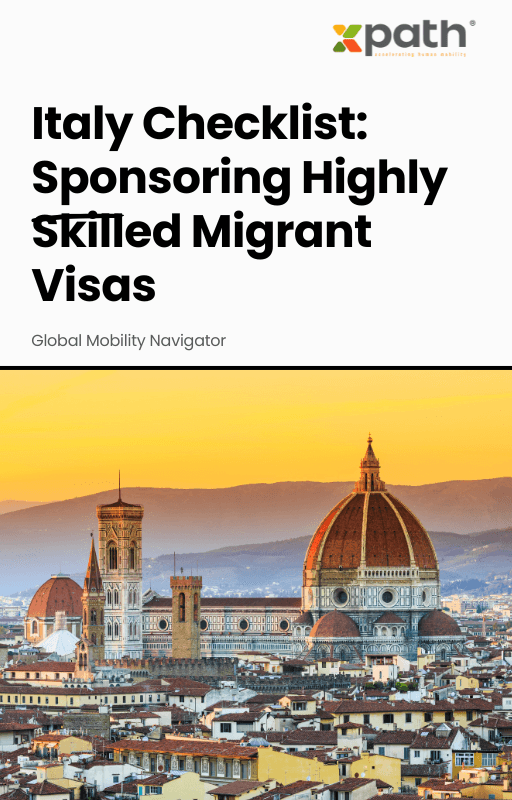Italy Checklist: Sponsoring Highly Skilled Migrant Visas
Grab a copy of a guide to international employee relocation
View E-bookInternational businesses need to move talent seamlessly across borders. But if your company is looking to bring skilled foreign professionals into China, you’ll bump into a complex maze of red tape—most notably the Z Visa and work permit process. Let’s unravel this journey, show you what matters, and help you sidestep avoidable pitfalls!
Global mobility isn’t just about moving people—it’s about unlocking value. China remains one of the biggest magnets for international business and investment thanks to its ever-growing market and tech-driven industries. That means foreign professionals play a pivotal role in everything from automotive design to fintech innovation. But let’s face it: the Z Visa isn’t just a stamp in a passport; it’s the green light for professionals to contribute legally and effectively.
The Z Visa is China’s official work visa—a golden ticket to employment within Chinese borders. Specifically, the Z Visa is reserved for foreign nationals intending to work in China. To put it simply, if you’re accepting a job in China that isn’t part of a diplomatic or journalism mission, you probably need this visa. But here’s the clincher: you can’t legally work in China unless you pair your Z Visa with a government-issued work permit.
For context, data from China’s Ministry of Science and Technology indicated that over 950,000 expats held valid work permits in 2023, up from fewer than 700,000 just a decade ago. This surge highlights the growing need for streamlined solutions to navigating the system.
Let’s slice through the bureaucracy with a simplified journey:
First, your employer must secure a job offer and a Notification Letter of Foreigner’s Work Permit—this is like getting the golden ticket before you even enter the country. Next, you submit your visa application (with this letter) at a Chinese consulate or embassy. Once you enter China with your Z Visa, you’re not quite home free: you have to convert this visa into a residence permit within 30 days, while your work permit is formally issued and tied to your employer.
Sounds straightforward? In reality, 60% of foreign professionals report administrative hurdles—from sudden policy changes to document translations and medical check snafus (source: China Briefing 2023).
Think of the Z Visa process as a relay race—if any baton gets dropped, everything slows down. A few common tripping points include:
That’s why companies—particularly those managing multiple relocations—are increasingly relying on specialized global mobility solutions to keep things on track.
Consider a leading European automotive company that expanded into Shanghai in 2022. Traditionally, their HR teams juggled dozens of relocation cases manually, leading to delays and even a few rejected permits. By shifting their processes to xpath.global’s global mobility platform, they automated document checklists, received real-time alerts for expiring visas, and accessed up-to-date regulatory requirements for each city. The result? They cut processing times by 35%, slashed escalation issues, and improved relocation experiences—something that also helped with talent retention longer term.
China’s government has started embracing digital systems for some work permit processes. For example, cities like Shanghai and Beijing now allow portions of the application to be submitted online, reducing wait times and physical paperwork. One McKinsey report highlights that almost 75% of multinational firms now use digital immigration tracking for compliance, forecasts, and streamlining their mobility programs—up from just 40% in 2018. Smart companies use platforms like xpath.global to centralize status dashboards, automate reminders for renewals, and ensure all compliance boxes are ticked well in advance.
Start Early: Never underestimate how long the background paperwork (police checks, diploma authentication) can take.
Stay Informed: Regulations can change city-by-city. Regularly check updates with local authorities or use mobility platforms with real-time compliance feeds.
Outsource Where Possible: If your HR team is already overloaded, using global mobility service providers like xpath.global can be the difference between a smooth landing and a headache. You’ll get access to vetted specialists and reliable updates, minimizing costly mistakes.
Relocating foreign professionals to China shouldn’t feel like reinventing the wheel. With the right preparation—and the right technology partnerships—you can make the Z Visa and work permit process much less daunting. Want to future-proof your company’s international workforce? Now’s the time to explore smarter mobility solutions that put your people first, keep your business compliant, and paint a seamless relocation experience.
Q: Can I work in China with just a Z Visa?
No. You must obtain both a Z Visa (to enter China for work) and a separate work permit and residence permit once inside the country to legally work. They go hand-in-hand!
Q: How long does the whole process take?
Expect 2–3 months on average, though it can move faster with digital solutions and centralized tracking—especially if you start paperwork early!
Q: What documents are hardest to obtain or get verified?
Police clearance certificates and diploma verifications often require extra steps and authentication, adding several weeks to the process.
Q: Why use a global mobility solution like xpath.global?
You’ll centralize your document management, get real-time regulatory updates by location, reduce compliance risk, and lighten the HR load dramatically.
Q: Are regulations the same across all of China?
No! Different cities and provinces have unique requirements and timelines, so always check with local authorities or use an expert partner.
Ready to transform your mobility program? Explore xpath.global’s solutions.

Italy Checklist: Sponsoring Highly Skilled Migrant Visas
Grab a copy of a guide to international employee relocation
View E-book